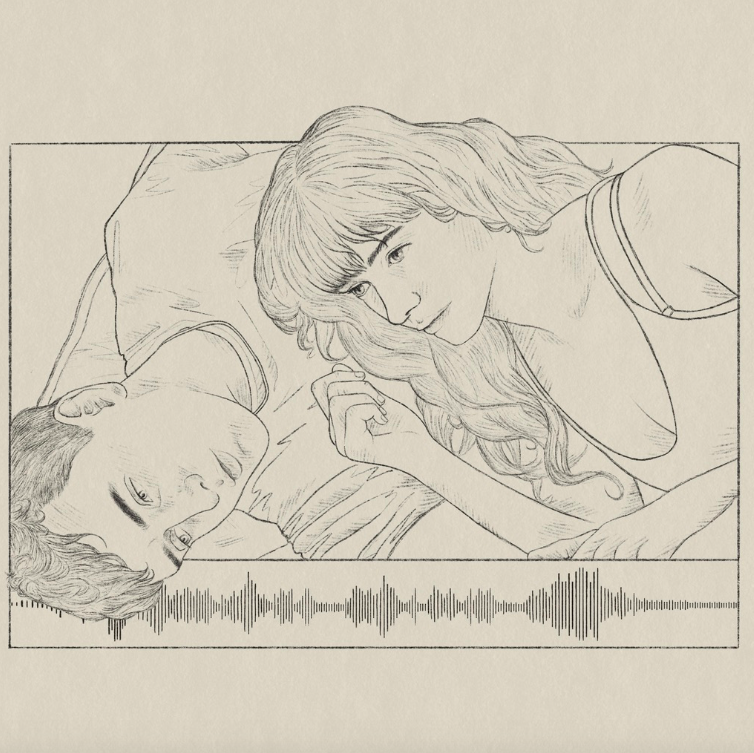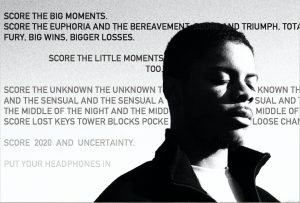
Sally Rooney’s Musical Marginalia
by Emily Formstone | March 30, 2023
Spotify is a virtual shelf-space upon which to stack year upon year of old playlists – to offer, in my case, an audible narrative to my late teens and early twenties. In the corner of Spotify occupied by the bibliophiles, I would scour for content, seeking new additions to my somewhat pretentious μύθος (mythos) playlist. The idea was simple: if there was ever a literary reference in a song, it got added.
That was until I stumbled across the seemingly unliterary user 1157094560, whose Spotify archive housed nine playlists. Each one was named after a protagonist of Sally Rooney’s novels. The playlists could have been mine: I had devoured each of Rooney’s novels in a day. Conveniently, or coincidentally, I’d even already liked an overwhelming majority of the songs. Before this, the thought of making book or character-specific playlists had never crossed my mind. In literary terms, this is a new form of marginalia. With handwritten curlicues and flourishes, marginalia have provided prying readers with literary insight since antiquity. Mimicking this form, playlists like these infuse the silent gaps around the page with a rich soundscape.
As I continued to work my way through the profile, the playlists’ dates of creation became increasingly bewildering: it struck me that they predated their corresponding novels. And so, I came to the realisation that they were the careful curation of Rooney herself. These playlists weren’t just intended to fill in white spaces for readers – they were created to aid a writer upon her blank page. This poses considerable analytical complications. If these mixtapes were forged by Rooney as tools for the process of composition, then the description of Normal People’s male lead, Connell, feeling “the old beat of pleasure inside his body,” as he writes “like […] a phrase of music from the window of a passing car…”, becomes self-referential. The playlisted songs now become the passing cars. The beat of their music resonates in Rooney, soon filtering into her observant reader.
This is by no means unprecedented. E.M. Forster’s Howards End frames a performance of Beethoven’s Fifth Symphony in literary terms, showing the potential for audible accompaniments to fiction. Forster’s delineation of Margaret Schlegel’s ability to “only see the music” draws us to an important question: might the introduction of music blind us to the possibilities of the page? I don’t think so. External music is available as a separate force for readers wishing to look beyond the bounds of a novel, casting themselves as the conductors of their own marginal ensemble. We may choose to listen to Beethoven, or rely entirely on Forster’s description – we have an interpretive choice. An awareness of Rooney’s playlists allows her musical references to garner greater significance. “We could hear the music buzzing through the floorboards, like a ringtone belonging to someone else…”: Conversations with Friends sees the Rooney-designed world permeated from the outside world by the cadence of her playlists.
It is in her playlist ‘Connell’, that this literary-musical fusion resonates best. For those that haven’t read the book, you may be familiar with Connell’s onscreen portrayal by breakout star Paul Mescal, whose famous chain and subtle charm created a new wave of Rooney admirers. It’s surely no coincidence that Mescal created a ‘Connell’ playlist of his own, lifting many of the tracks featured in Rooney’s setlists. Rooney’s ‘Connell’ takes the digital form:
‘Cyprus Avenue’ (Van Morrison)
‘Cristina’ (Teleman)
‘Jamie Marie’ (Girls)
‘Common People’ (Pulp)
‘Futile Devices’ (Sufjan Stevens)
‘Hotline Bling’ (Drake)
‘Your Fine Petting Duck’ (Devendra Banhart)
‘Old Town’ (Phil Lynott)c
‘715 – CRΣΣKS’ (Bon Iver)
‘Ivy’ (Frank Ocean)
‘So Long, Marianne’ (Leonard Cohen)
As with any themed Spotify playlist, there are visual elements at play. There is the lexical banter of the title to consider, and then the curated aesthetic of the cover photo. But I pay most attention to the ordering. It is a call back to the somewhat lost art of album-listening where the shuffle button has no place. Reading the titles of the playlisted songs in their concrete order is akin to reading a poem. With this poetic lens, ‘Connell’ tells the tale of a young man’s foray into the world of relationships – he jumps from significant lover to insignificant lovers, eventually becoming disenchanted and looking to his roots before saying farewell to his first love.
But are these songs merely picked to be those Connell would listen to, or are they songs inspired by the character? The answer is both, since, as self-absorbed beings, we tend to enjoy relatable artistic expression. Much of the success of Normal People can be put down to Rooney’s relatability factor: her characters often resemble the main demographic of her readers. To take one extreme example, a friend of mine had an identity crisis after reading the novel because she saw so much of herself in Connell, particularly his struggle with imposter syndrome.
Rooney hasn’t just created a sonic aesthetic – her musical choices have clear lyrical relevance to her subjects. Let us take Van Morrison’s line from ‘Cyprus Avenue’, which seems to abridge the crescendos and diminuendos of Connell’s character arc: “my tongue gets tied every time I try to speak”. He is notoriously tongue-tied, both verbally and internally: the secret playlists introduce readers to a symphony of his self-expression. Some of this is light-hearted – take a moment to imagine him nodding his head to ‘Hotline Bling’ as he muses over Marianne “wearing less and goin’ out more” following her matriculation at Trinity College. Banhart, singer of ‘Your Fine Petting Duck’, gives a more downhearted rendition of Connell’s inability to express himself. The lyric, “If he doesn’t give enough time / Please remember that I never gave you mine” reminds the listener of Connell’s guilt at his reluctance to publicly acknowledge his relationship with Marianne. The interlocking male and female voices of the duet replicate Normal People’s chapter structuring, where the perspective oscillates between the equally awkward Connell and Marianne. Just as Rooney’s narrative technique separates the couple’s already disparate realities, her chosen songs, ‘Cristina’ and ‘Common People’, trace the thread of young love between those from different financial backgrounds. Can we really ignore the similarity between the titles ‘Common People’ and Normal People ?
But the leitmotif of Connell’s struggle with self-expression, and particularly with words, resurfaces in ‘Futile Devices’. “Words are futile devices”: the song reminds us of the paradoxical creation of a character whose speechlessness must be rendered through Rooney’s use of words. As well as focalising sonic art, musical marginalia highlight the silent moments of a text. Rooney, writing in the Irish literary tradition, celebrates both her words and their origins by featuring two Irish musicians in ‘Connell’. Coming from a family of Irish singers myself, I was understandably drawn in. The first is Van Morrison, who sings of how his “inside shakes just like a leaf on a tree” as he ponders “that mansion on a hill.” As “trees wave silvery individual leaves in silence,” we think of Connell and Marianne driving away from her large home toward the end of the novel. The silence of the narrative events stand in stark contrast to the musical whispers in the margins. It doesn’t take much to imagine the radio playing ‘Cyprus Avenue’ as the car crawls away. Second comes Phil Lynott. His song, ‘Old Town’ is more directedly related to Connell, buoyantly describing how “This boy is cracking up / This boy has broke down.” Paired with Rooney’s use of Irish musicians, this reminder of his struggles with mental health might prompt us to consider the wider cultural struggle for identity.
And then comes Frank Ocean. Beneath their surface, the songs are all love ballads – but Ocean’s ‘Ivy’ is easily the most graceful. He captures the innocence of teenage infatuation and, as the penultimate song on ‘Connell’, it strikes a harmonic, erotic chord. Ocean’s verses embody Marianne’s emotions upon Connell’s profession of love: “Even in memory she will find this moment unbearably intense, and she’s aware of this now, while it’s happening.” Connell and Marianne are combined into a canta of existence through the novel form. The pair are beautifully imagined as growing “like two little plants sharing the same plot of soil […] around one another…” Think of the novel as the joint “soil” and the playlists as the separate plants. In Normal People, Marianne’s dependence on Connell is surfaced when she is described as having “pale collarbones like two white hyphens.” The image of an isolated Marianne, made up of hesitant punctuation marks, paints her as an object waiting to be analysed, much like the playlists. Rooney chooses not to punctuate the speech in Normal People, leaving it up to the reader to distinguish between spoken word, thought, and action. This silences the novel and its quiet, internal characters. It allows the playlists to punctuate our reading of the text.
The final instalment of ‘Connell’, Leonard Cohen’s ‘So Long, Marianne’, is the most overtly relevant title. Without spoiling too much, it coincides with the atonal ending of Normal People. Added to the playlist almost a year after the main bulk of songs, Rooney now joins Cohen and Connell in saying goodbye to Marianne. It is no surprise that its closing line is unashamedly emotional: “It’s time that we began / To laugh and cry / And cry and laugh about it all again.” Turning to Rooney’s ‘Marianne’ playlist, its final lyric is itself a reaction to Cohen’s conclusions: “You still saw me cry.” Rooney not only used her playlists as a basis for her own formation of character identity, but also for her characters’ responses to each other.
As readers, we are exposed to a cacophony of forms of creative expression on a day-to-day basis. User 1157094560’s playlists are evidence that authors are not immune to the multimedia reality of our time. Rooney likely saw herself in the music and, in turn, imprinted these aspects into her characters. As a long-standing fan of these songs, I can’t help but wonder whether my interpretation arises from a narcissistic reading of my own tastes into the margins of her work than anything else. I’m yet to find an answer. But I think an awareness that we as readers are already confined within our own margins of experience is crucial to understanding how we relate to and enjoy literature. We can find solace in Marianne’s thought that Connell’s “appearance is like a favourite piece of music to her, sounding a little different each time she hears it”: there is still space for interpretation in the playlists’ existence. Rooney’s novels sound different in the light of her musical marginalia, and they will sound different upon each rereading, relistening, and retelling
Words by Emily Formstone. Art by Frankie Frazer.




